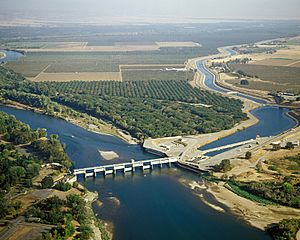Red Bluff Diversion Dam facts for kids
Quick facts for kids Red Bluff Diversion Dam |
|
|---|---|

Aerial view looking downstream, dam gates partially open. Diversion works and Tehama Colusa Canal are to the right.
|
|
| Country | United States |
| Location | Tehama County, California |
| Coordinates | 40°09′13″N 122°12′09″W / 40.15361°N 122.20250°W |
| Purpose | Irrigation |
| Status | Decommissioned |
| Construction began | 1962 |
| Opening date | 1964 |
| Construction cost | $3,465,155 |
| Owner(s) | U.S. Bureau of Reclamation |
| Dam and spillways | |
| Type of dam | Concrete gravity |
| Impounds | Sacramento River |
| Height (foundation) | 52 ft (16 m) |
| Length | 5,985 ft (1,824 m) |
| Elevation at crest | 256 ft (78 m) |
| Dam volume | 9,630 cu yd (7,360 m3) |
| Reservoir | |
| Creates | Lake Red Bluff |
| Total capacity | 4,170 acre⋅ft (5,140,000 m3) |
| Catchment area | 8,900 sq mi (23,000 km2) |
The Red Bluff Diversion Dam is a large structure on the Sacramento River in Tehama County, California, United States. It was built to help farmers get water for their crops. Until 2013, this diversion dam sent water to two big canals. These canals helped irrigate about 150,000 acres (61,000 hectares) of farmland.
The dam and its canals are part of a bigger project called the Central Valley Project. This project is managed by the U.S. Bureau of Reclamation. In 2013, the dam was stopped from working as it used to. This change was made to help protect fish that migrate, like salmon. Now, the river flows freely through the dam's location. A new pumping station built nearby now sends water to the canals instead.
Contents
What the Dam Looked Like
The Red Bluff Diversion Dam was made of concrete. It was designed with gates that could open and close. The dam was very long, stretching about 5,985 feet (1,824 meters) across the river. It stood about 52 feet (16 meters) tall.
Dam Gates and Water Flow
The dam had eleven large gates. Each gate was 60 feet (18 meters) wide and 18 feet (5.5 meters) high. These gates controlled how much water flowed down the Sacramento River. When the gates were closed, they created a small lake called Lake Red Bluff. This lake was about 13 feet (4 meters) deep.
Canals for Farming
The dam's main job was to send water into two canals. These were the Tehama-Colusa Canal and the Corning Canal. The water would flow by gravity into these canals.
- The Tehama-Colusa Canal is the longer one, at 110.9 miles (178.5 kilometers) long. It could carry a lot of water, about 2,530 cubic feet (72 cubic meters) per second.
- The Corning Canal is shorter, about 21 miles (34 kilometers) long. It could carry about 500 cubic feet (14 cubic meters) of water per second.
Together, these canals provided water to 150,000 acres (61,000 hectares) of farmland. This helped farmers grow crops in Tehama, Glenn, Colusa, and Yolo Counties. The water also helped 20,000 acres (8,100 hectares) of wildlife areas in the Sacramento Valley.
Building the Dam
The idea for the Central Valley Project started in 1935. However, the part that included the Sacramento Canals was approved later. President Harry S. Truman gave the go-ahead on September 29, 1950.
Construction of the Red Bluff Diversion Dam began in 1962. It was built by a company called Vinnell Corporation. The dam was finished quickly, on August 9, 1964. This was more than four months ahead of schedule. The Corning Canal was ready by 1959. But the much larger Tehama-Colusa Canal took longer and was completed in 1980.
Helping Fish: Environmental Impact
Even though the dam was not huge, it caused problems for fish. Fish like salmon, steelhead, and sturgeon swim upstream to lay their eggs. The dam blocked their path on the Sacramento River. This hurt the fish populations.
Challenges for Migrating Fish
The fish ladders, which are like stairs for fish, did not work well at first. Also, when water was taken out for the canals, it created strong currents. These currents made it hard for fish to find their way.
To help, a special screen was put in place between 1969 and 1971. This screen stopped fish from accidentally swimming into the canals. Later, a new fish ladder was built.
Changes to Dam Operations
Starting in 1987, the dam gates were left open for part of the year. They stayed open from December 1 to April 1. This was done to help the winter Chinook salmon swim upstream. However, this change did not help the fish populations much. In 1991, the number of winter Chinook salmon was very low.
By 2008, the dam gates were open almost all year. They were only closed during the main farming season, from mid-May to mid-September. Still, the number of migrating fish remained low.
Decommissioning the Dam
In 2009, a group called the National Marine Fisheries Service made a big decision. They ordered that the dam gates be kept open all year round. This allowed the river to flow freely, helping the fish.
To make sure farmers still got water, a new pumping station was built upstream. This station now lifts water directly from the Sacramento River into the canals. This made the Red Bluff Diversion Dam no longer needed for its original purpose.
In 2013, the dam was officially decommissioned. Its gates are now permanently locked in the open position. This decision was a bit controversial because Lake Red Bluff, which was formed by the dam, was a popular place for recreation. However, the main goal was to help the fish populations recover. The total cost to help the fish above Red Bluff Dam has been about $180 million.

